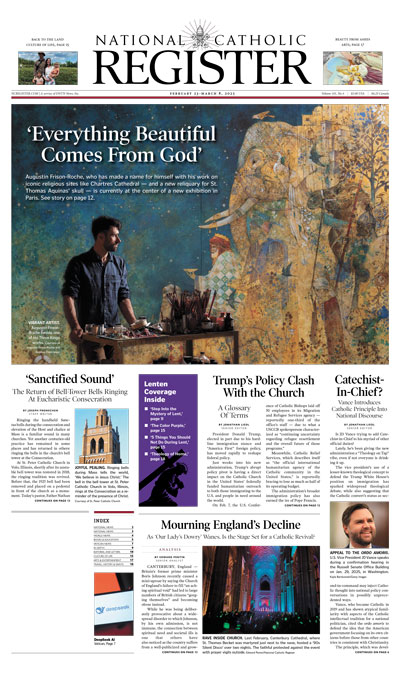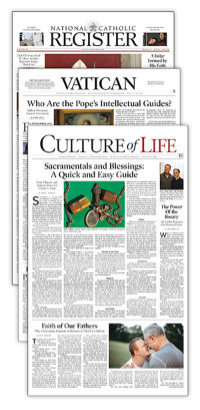Amid Ice and Isolation, Catholic Community Grows in Greenland
From Viking ruins to Filipino families, a small Catholic community brings new life to the Church’s oldest frontier.

The Catholic Church arrived in Greenland a very long time ago. Before President Donald Trump raised the issue of American acquisition in 2019, before the United States first attempted to buy the island in the 1860s, before it belonged to the Norwegians and later the Danes — and even before the arrival of the native Thule Inuit people around A.D. 1300 — there were Catholics in Greenland.
The original Norsemen who brought the faith across the ocean are no longer there, of course, and today more than 95% of Greenland’s roughly 60,000 inhabitants are Protestant, mostly Danish Lutheran. But Catholicism is growing, thanks largely to an influx of immigrants from the Philippines — a place that could scarcely be more different. Despite having some of the very first churches in the Western Hemisphere, Greenland is one of the Church’s newest frontiers.
A Millennium of History
The Church’s presence on the island dates back to the settlement by Erik the Red and the first Vikings in A.D. 985. A warmer climate made southern Greenland hospitable to farming, and the Norse settlers remained for several centuries before quietly and mysteriously disappearing sometime in the 1400s. The last known record of their presence is a written account of a marriage in 1408 at the church in the village of Hvalsey, near the island’s southern tip. The ruins of that church are the oldest surviving remnants of a church in the Americas.
Christianity returned to Greenland in 1721, when Lutheran missionary Hans Egede set sail from Norway, determined to bring the Catholic Norse Greenlanders the message of the Protestant Reformation. He didn’t find any Europeans, but he began to evangelize the native Greenlandic people.
Greenland was largely cut off from the world outside Denmark until 1953, when it shifted from a colony to a fully integrated county of Denmark and began to open up. This paved the way for the return of resident Catholic priests for the first time since the Middle Ages.
Mission on the Margins
One of those early priests was Father Paul Marx, a native of Minnesota (not to be confused with the founder of Human Life International). While studying to be a priest of the Missionary Oblates of Mary Immaculate, he befriended a half-Greenlandic, half-Danish seminarian who had converted to the faith — an encounter that piqued his interest in the island. He was the only seminarian to request assignment in Greenland after ordination, and in 1967, he arrived. Theodor Suhr, the bishop of Copenhagen at the time, had been impressed by the character of American soldiers stationed in Greenland in World War II and was eager to find American priests for the brand-new Greenland mission.
Before the first priests arrived, Father Marx recalls, local Lutheran pastors warned Greenlanders that they would come knocking in strange black robes and wide-brimmed hats, hoping to pull them away from their Christian faith and into their strange, foreign religion. But once the priests arrived, the Greenlanders were quickly won over. The priests were interesting and approachable. One even brought a motorcycle — an incredible sight for the locals — and gave children rides around town.
Father Marx, who now serves in the Copenhagen area, ministered to Greenland’s Catholics for about 24 years, off and on, until 2009. In the early years, he recalls, the Catholic population was sparse and his ministry felt like an adventure. He traveled up and down the western coast, serving Catholics scattered in extremely remote locations. One winter, while traveling by boat for a baptism, storms shifted the icebergs, and what was supposed to be a three-week journey turned into seven weeks on the cold sea.
The Church Today
The Catholic community in Greenland remains very small. According to estimates from the World Religion Database, even the small portion of the population that still identifies with traditional Greenlandic pagan beliefs outnumbers Catholics three to one.
On an island roughly the size of Mexico, there is only one Catholic church. Christ the King parish, in the capital of Nuuk (population 20,000), offers one Mass each Sunday, always in English. Father Tomaž Majcen, a Slovenian Conventual Franciscan, has served as pastor since the summer of 2023. He estimates there are about 500 Catholics living in Greenland — some 300 in Nuuk and the rest dispersed throughout the country.
The Church in Greenland today is entirely a church of immigrants. Nearly all Catholics on the island are from the Philippines, many of whom work in the fishing industry.
It marks a significant change from when Father Marx last served as pastor in 2009.
“When I was there in August and September 2023, the entire congregation in Nuuk ... was only Filipinos,” he says. “Not just women married to Greenlanders or Danes, but whole families.”
The fledgling Catholic community is growing and “deeply devoted,” says Father Majcen. The year 2024 was especially fruitful, with seven baptisms, 10 first communions and a confirmation.
Still, Greenland presents unique challenges for those living the faith. Some Catholics live in very remote locations and may go months — or even years — without seeing a priest.
Faith Without Walls
Marisa Maniago moved from the Philippines to Greenland 17 years ago and now lives in Ilulissat, a town of about 5,000 located a two-hour flight north of Nuuk. There is no Catholic church in town, so the faithful gather in homes for Mass when priests visit. Last year, they received only two such visits.
“It’s so hard, really, without a church,” she says. “I think the faith is [each person’s] own responsibility, because [when] I talk to the people, they just watch Mass online or they just do the Rosary.”
The internet is a crucial — and sometimes primary — source of formation for Greenland’s Catholics.
“Modern technology, including live-streamed Masses, online Catholic resources, and social media, helps bridge the gap,” says Father Majcen. “Lay Catholics play a much larger role in maintaining their faith life through private prayer, Bible reading and small community gatherings.”
The internet also allows them to stay in regular contact with Catholic family and friends back home. Lara May Diaz arrived in 2020 on the last flight carrying foreigners before the border was closed due to COVID-19. For her, one of the hardest parts of living the faith in Greenland is being away from the Couples for Christ ministry that she and her husband were involved in back in the Philippines. During the pandemic, they were able to attend video meetings, and although it has been more difficult since then, they remain involved.
Life in cold, dark, remote Greenland can be isolating and lonely for anyone — especially for Filipinos far from home. Serious social challenges like alcoholism and suicide are widespread on the island. The parish in Nuuk, though, is a refuge, says Diaz.
“It’s really hard [being] far away from your real family. But you will have a second family with all the other Catholic Church members here. That’s the best thing about being Catholic here.”
They also maintain a distinctly Filipino expression of their Catholicism, including traditions like Simbang Gabi — nine days of early-morning Masses leading up to Christmas.
Plowing in Permafrost
For Greenland’s native population, the path to the Church is neither easy nor well-trodden. Conversions among native Greenlanders are exceedingly rare. Father Marx says he knows of only four from his decades of service there.
Father Majcen recalls the story of a native Greenlandic Lutheran woman who became fascinated with Catholic spirituality after an encounter with a priest. She began reading the Catechism and spent years deliberating about joining the Church.
“When she openly declared her Catholic faith,” he says, “she faced isolation from her family and community, yet she remained steadfast.”
In Father Marx’s estimation, the Lutheran church remains more vibrant than back in Denmark — one of the world’s least religious countries — but not by much. Nuuk, he explains, feels much like a modern European town.
“Most of the people here don’t have faith. They don’t believe in God,” says parishioner Louie Manero. “Most of them are not interested when it comes to religion.”
He also finds the Filipinos to be less active in their faith than back home. Despite Nuuk’s sizable Filipino community, Sunday Mass attendance typically ranges between 20 and 30 people.
Catholics are not the only non-Lutheran faith group in Greenland. Non-denominational Protestant churches and Jehovah’s Witnesses are also present. Maniago notes that the Jehovah’s Witnesses, in particular, seem more active — they often knock on her door and frequently hold Bible studies.
Despite the challenges, the faith is alive. For some, living in a place where following Christ is a personal choice — rather than a cultural expectation — has deepened their spiritual lives. Maniago says she feels closer to God in Greenland.
“I feel like I’m more near to him,” she says. “I talk much [more] often to him [compared to when] I was in the Philippines. Even though there’s no church ... I can hear him, I can talk to him directly.”
For Father Majcen, the calm and quiet of Greenland is a blessing.
“From the very beginning, this land was for me the place of grace and peace where I can rest my body and soul. At the same time, it gives me a chance to reflect deeply on my spiritual life and when I can truly step away from the hustle and bustle of everyday life,” he says. “The beauty of Greenland’s landscapes and the deep sense of mission can make it a rewarding but demanding calling.”
Like the ancient Norsemen of centuries past, he and his flock are — more poignantly than most — living out Christ’s call to witness “to the ends of the earth.”


















